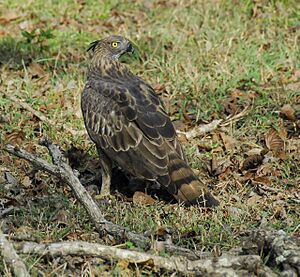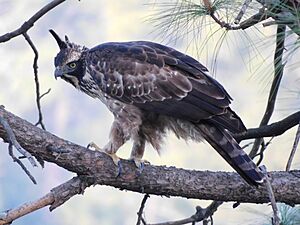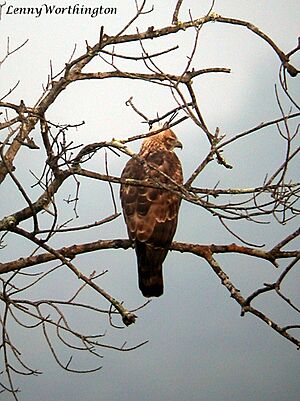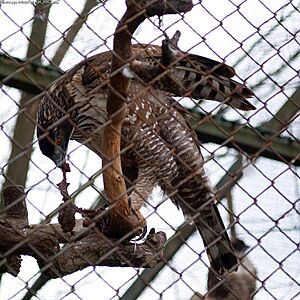Mountain hawk-eagle facts for kids
Quick facts for kids Mountain hawk-eagle |
|
|---|---|
 |
|
| An adult mountain hawk-eagle in flight, West Bengal, India | |
| Conservation status | |
| Scientific classification | |
| Genus: |
Nisaetus
|
| Species: |
nipalensis
|
| Subspecies | |
|
|
| Synonyms | |
|
|
The mountain hawk-eagle (Nisaetus nipalensis) is a large bird of prey found in Asia. It's also called Hodgson's hawk-eagle after Brian Houghton Hodgson, a naturalist who first described it. Another name for it is the feather-toed eagle because of its feathered legs. Like all eagles, it belongs to the Accipitridae family.
These eagles live and breed in places like India, Nepal, Bangladesh, Thailand, Taiwan, Vietnam, and Japan. They were once grouped with other hawk-eagles, but scientists found they are a unique group. Mountain hawk-eagles live in forests and hunt different animals, including birds, mammals, and reptiles. Even though they are found over a wide area, they are often rare. Their numbers are decreasing because their forest homes are being cut down.
Contents
About the Mountain Hawk-Eagle
Size and Appearance
The mountain hawk-eagle is a large and strong eagle. It's usually the biggest of the 10 types of hawk-eagles in its group, Nisaetus. These eagles can be about 69 to 84 centimeters (27 to 33 inches) long. Their wings can spread from 134 to 175 centimeters (4.4 to 5.7 feet) wide. Female eagles are usually a bit bigger than males, by about 3-8%.
Mountain hawk-eagles have a short, strong beak, a long crest (a feathery tuft on their head), short wings, a long tail with three bands, and feathered legs with powerful feet. They often sit quietly in the trees.
There are two main types, or subspecies:
- The N. n. nipalensis type lives across mainland Asia.
- The N. n. orientalis type lives in Japan and possibly Taiwan. This Japanese type is about 9% larger and has a longer tail and wings. It also looks a bit paler underneath.
A hawk-eagle found in Sri Lanka and southwestern India was once thought to be a mountain hawk-eagle subspecies. But studies in 2008 showed it's actually a separate species called Legge's hawk-eagle. Legge's hawk-eagle is smaller and looks different, especially with paler markings.
Colors and Similar Birds
Adult mountain hawk-eagles are dark brown on top. Their heads are reddish with strong black stripes. They have a black crest with a buffy tip. Their tail is grey-brown with a white tip and dark bands. Their throat has bold black stripes. The rest of their underside is mostly white with reddish-brown bars. Their legs are also barred.
Young mountain hawk-eagles are dark brown on top but have creamy or whitish feather edges, making their wings look "scaled." Their tail has thin light and dark brown bands. Their underside is plain buffy to tawny. They get their adult markings and tail by their third or fourth year.
Adults have golden or yellowish-orange eyes, while young ones have pale blue-grey or yellow eyes. Their feet are dull yellow to yellowish-white.
In flight, they have a noticeable head and short, rounded wings. They can fly fast and are very agile. They usually glide with strong, shallow wing beats. When soaring, they hold their wings in a shallow "V" shape.
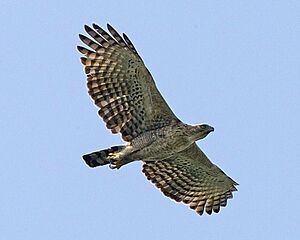
It can be hard to tell mountain hawk-eagles apart from changeable hawk-eagles. However, changeable hawk-eagles are usually slimmer and have longer tails. They also have narrower wings. Young birds are harder to tell apart, but mountain hawk-eagles look bulkier.
Other similar birds like Blyth's hawk-eagle and Wallace's hawk-eagle are much smaller. The crested honey buzzard is also different, with bare legs and a smaller head.
Calls and Sounds
Mountain hawk-eagles are usually quiet unless it's their breeding season. Their call is a high, shrill sound, often compared to a penny whistle. People describe it as klu-weet-weet or kee-kikik. In Japan, it's sometimes written as pie-pie-pie or pipipi. Both male and female eagles call while flying or perched. They also make a fast, bubbling sound during their special sky-dances.
Where They Live
Mountain hawk-eagles live in the Himalayas, from northeastern Pakistan through northern India, Nepal, and Bhutan. Their range extends into Myanmar, Thailand, Laos, Vietnam, and southeastern China. They are also found on the islands of Taiwan and Japan.
They usually stay in one area, but some eagles, especially younger ones, might move to lower areas in winter. For example, some Japanese eagles move to the Korean peninsula. They have also been seen as rare visitors in places like Hong Kong and Cambodia.
These eagles prefer dense hill and mountain forests, often near streams. They live in different types of forests, from cool subtropical forests to tropical rainforests. In the Himalayas, they are usually found between 600 to 2,800 meters (2,000 to 9,200 feet) above sea level. In Japan, they live a bit lower, between 250 and 1,500 meters (820 to 4,900 feet).
Life in the Forest
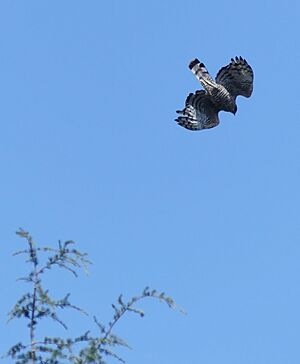
Mountain hawk-eagles are well-suited for forest life. Like other forest raptors, they have a long tail, short, wide wings, and strong legs. These features help them move quickly and strike prey in thick woods. They are often compared to "true hawks" because of these adaptations.
Even though their body shape might suggest they hunt mostly birds, studies show they are generalist hunters. This means they eat whatever prey is available. They often prefer small mammals, but they also hunt birds and reptiles.
They usually hunt by sitting quietly on a hidden branch, then swooping down to catch their prey on the ground. They can also chase birds in the air or ambush animals from a perch. Mountain hawk-eagles are known for being strong and powerful, even taking surprisingly large prey.
What They Eat
In Taiwan, a study found that mountain hawk-eagles mostly eat giant flying squirrels. These squirrels are quite large, weighing about 1.65 kg (3.6 lbs) on average. Smaller squirrels were also a common food source. They also hunt birds like the Swinhoe's pheasant.
In Japan, one pair of eagles mostly brought small birds and Japanese shrew moles to their nest. However, the female eagle also brought larger snakes and Japanese hares, which can weigh up to 2.5 kg (5.5 lbs).
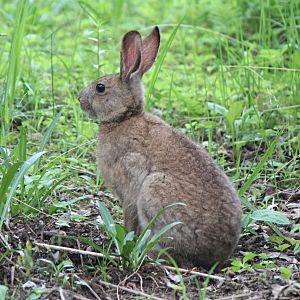
These eagles can attack very large prey, sometimes even bigger than themselves. They have been seen hunting young ungulates (hoofed animals) like Formosan serow and wild boar piglets, weighing around 2 kg (4.4 lbs). They have even attacked newborn sika deer that weigh at least 4.5 kg (10 lbs).
Large birds are also on their menu, including adult Indian peafowl (up to 4 kg or 8.8 lbs) and large water birds like mallards, grey herons, and even large geese.
Mountain hawk-eagles also hunt Carnivorans. They have taken young Japanese badgers and adult Chinese ferret-badgers. More impressively, they have caught adult yellow-throated martens (2.75 kg or 6 lbs), red pandas (4.5 kg or 10 lbs), and even raccoon dogs (6.5 kg or 14 lbs). They have also been known to take domestic cats.
They sometimes hunt primates, usually young ones. They have taken infant Formosan rock macaques and juvenile Assam macaques. In one amazing case, a large female mountain hawk-eagle was seen taking an adult Japanese macaque weighing between 8.3 and 10 kg (18 to 22 lbs)!
Other Animals in Their World

Mountain hawk-eagles share their forest homes with other large eagles, but they usually stick to the dense forests, which helps them avoid competition. Some people compare them to the crowned eagle of Africa, another powerful forest hunter.
They also live alongside other hawk-eagles and smaller hawks, but these birds usually hunt smaller prey. Large owls, like the spot-bellied eagle owl, also live in their range and hunt similar animals, even though owls hunt at night.
In Japan, the mountain hawk-eagle is the fourth largest eagle after the Steller's sea eagle, white-tailed eagle, and golden eagle. Even though the golden eagle is slightly larger, the mountain hawk-eagle is better at hunting in forests. They sometimes compete for prey like Japanese hares.
Mountain hawk-eagles sometimes prey on other birds of prey, including young black eagles. They also hunt various owls, such as Asian barred owlets, jungle owlets, brown boobooks, barn owls, and Ural owls. They have even been reported to attack a Eurasian eagle-owl, which is a powerful owl similar in size to the hawk-eagle itself!
Reproduction and Life Cycle

Mountain hawk-eagles perform amazing aerial displays to mark their territory before breeding. They fly in high circles, diving and climbing while making bubbling calls. This display helps them show other eagles that the territory is theirs and strengthens the bond between the male and female.
The breeding season is from February to June in the Himalayas and April to July in Japan. They build large stick nests, which can be up to 1.8 meters (6 feet) wide and 90 to 120 centimeters (3 to 4 feet) deep after being used many times. They might have a few nests, but usually only use one at a time. The male brings most of the sticks, and the female builds the nest. They line the nest with fresh green leaves or conifer branches.
Nests are usually high up in large forest trees, about 12 to 30 meters (39 to 98 feet) off the ground. They often choose trees near steep ravines or open areas, giving them a good view.
They usually lay 1 or 2 eggs, but sometimes up to 3 in Japan. The eggs are pale clay-colored or reddish with darker spots. Only the female incubates the eggs, and the male brings her food.
The female eagle is very protective of her young. She is known to be very aggressive if her nest is disturbed, even attacking humans who come too close. This protective behavior is much stronger than that of some of their relatives. They have been seen driving away animals like rhesus macaques and yellow-throated martens, which are known to raid nests.
The male eagle brings food to the nest, sometimes twice a day. The young eagles start stretching their wings after about three weeks. The female then perches nearby, still watching over them. The young can feed themselves soon after but are often fed by their mother for a while. The family stays together for some time after the young eagles learn to fly. In India, it takes at least 53 days from hatching for the young to leave the nest.
Conservation Status
The mountain hawk-eagle is not considered a globally threatened species, but it is uncommon or rare in many places. It lives across a huge area, but its numbers are not very high.
The biggest threat to these eagles is the loss and damage of their forest homes. As human populations grow in places like northern India, southeastern China, and Japan, more forests are cut down. Sometimes, they are also hunted if they prey on farm animals.
Even though they are popular in Asian falconry, this is probably not a major threat. However, Lead poisoning from eating deer killed by hunters using lead bullets has caused some eagle deaths.
The Japanese population of mountain hawk-eagles is especially declining. In the 1990s, there were about 900-1,000 eagles in Japan, and that number might be even lower now. Because eagles have few young and live long lives (a strategy called K-strategist), population drops can be very serious.



